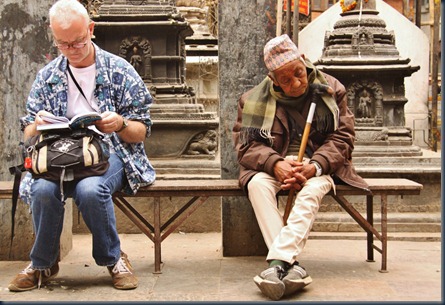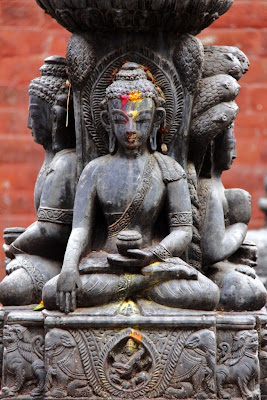Coming Soon to a Browser Near You:
Live Street Video : : 10 cameras : : 24 hours
Tuesday, December 28, 2010
Another Gigapixel Compilation
Photo by Alok Tuladhar.
Sunday, December 26, 2010
The Shining Silver Souvenir Promise
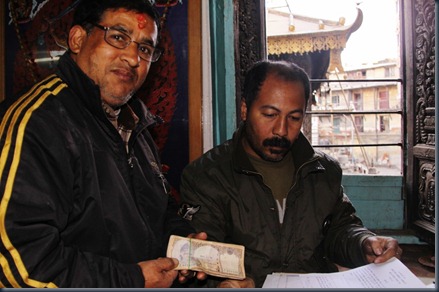 Hard cash is required (to pay the salaries, mostly) to continue the cleaning of Janabahaa. And, people do have a huge appetite for valuable mementos.
Hard cash is required (to pay the salaries, mostly) to continue the cleaning of Janabahaa. And, people do have a huge appetite for valuable mementos.Just perfect!
A group of youths from Janabahaa, led by Bijay Shrestha, have come up with a plan to raise the much-needed funds by selling a limited number of specially-marked silver souvenirs. The 15-gram relic will be released on the occasion of the annual bathing ceremony of the image of Janbahaa Dyo (Karunamaya Aryavalokiteshor), which falls on January 12, 2011 this year, and will be available for sale to the public on first-come-first-served basis.
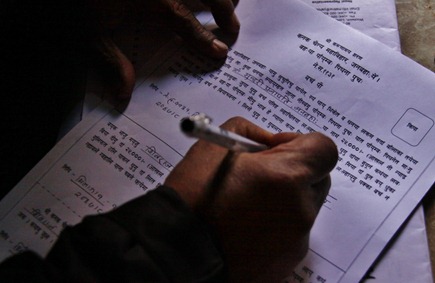 A lot of financial planning and resource mobilization goes into a task such as this. “Investment” for procuring the silver was raised from local individuals, who happily provided an interest-free loan of Rs. 25,000 each.
A lot of financial planning and resource mobilization goes into a task such as this. “Investment” for procuring the silver was raised from local individuals, who happily provided an interest-free loan of Rs. 25,000 each.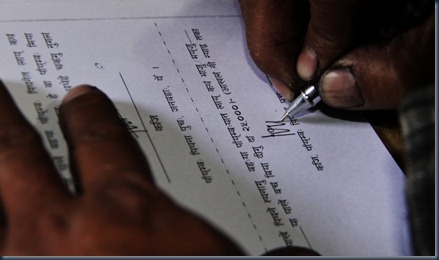 Each of the lenders has pledged that he/she will not ask that the money be returned until all the mementos are sold.
Each of the lenders has pledged that he/she will not ask that the money be returned until all the mementos are sold.A small “profit” from the sale of each unit of the souvenir, amounting to no more than a couple of hundred rupees, will be deposited in the Janabahaa cleanliness fund.
As the souvenir will be of 99.9 % sterling silver, its monetary value is bound to appreciate quickly. Additionally, as the token is directly linked to Janabahaa Dyo, many people will consider it a priceless possession, of which they will want never let go.
If you wish to ensure that you get your unit of this unique sterling silver souvenir, book it today by calling Bijay Shrestha (cell: 977.98510.35097) or Prabodh Kasaa (cell: 977.98414.79388).
Photos by Alok Tuladhar.
Monday, November 22, 2010
ANNOUNCEMENT: Weekly Free Clinics Resumed
 Dr. Matina Tuladhar has resumed her voluntary service as the physician on duty at the weekly clinics run by the Janabahaa Society (please see earlier post about this here).
Dr. Matina Tuladhar has resumed her voluntary service as the physician on duty at the weekly clinics run by the Janabahaa Society (please see earlier post about this here).
Clinic timings are 8 am to 10 am every Saturday morning, and the venue is the Janabahaa Society office in the Janabahaa complex.
The clinic is completely free. All are welcome.
Note: Karunamaya Aryavalokiteshor (Janabahaa Dyo), being the compassionate one, is believed to relieve the suffering of his devotees. In earlier times, when the holy water from the shrine of Janabahaa Dyo was sprinkled on the sick, they would be cured. The free clinic is one more way to help relieve the suffering of the ailing and the needy in modern times.
Friday, November 19, 2010
Caption Contest
Friday, November 12, 2010
Repoussé art in Janabahaa
Repoussé is used to work on the reverse of the metal to form a raised design on the front. The technique of repoussé utilises the plasticity of metal, forming shapes by degrees. There is no loss of metal in the process, as it is stretched locally and the surface remains continuous. The process is relatively slow, but a maximum of form is achieved, with one continuous surface of sheet metal of essentially the same thickness.
The zoom-able photo below shows some of the Repoussé art found on the ground floor or Janabahaa Dyo temple.
Photos by Alok Tuladhar
Sunday, November 07, 2010
Dilemma No More
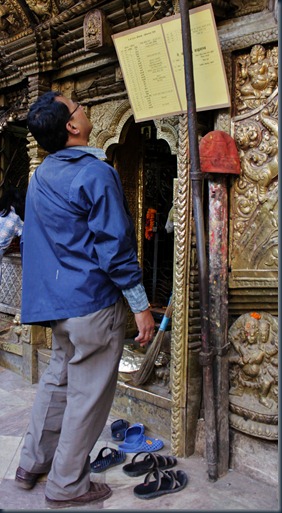 Not sure about the date of upcoming events and festivals? No problem. Just go to Janabahaa and check out the calendar hung next to the gate of the main shrine of Janabashaa Dyo.
Not sure about the date of upcoming events and festivals? No problem. Just go to Janabahaa and check out the calendar hung next to the gate of the main shrine of Janabashaa Dyo.
This is an example of how Janabahaa has been of practical use in one’s daily life for centuries. The debate about the dates of the Swonti (or Tihar) festival this year is addressed by this calendar – which authoritatively states that the Mha Puja and Nepal Sambat 1131 New Year’s day falls on Sunday, November 7. Happy New Year!
Photo by Alok Tuladhar.
Tuesday, October 05, 2010
It's Gigapixels Now, No More Megapixels!
Photo by Alok Tuladhar.
Vote for... compassion
The Election Commission is currently sending out teams all over the country to collect data on eligible voters. One such team arrived in Janabahaa on Monday. Many residents of Janabahaa enlisted themselves by providing the required information to the data collection team, ensuring that their voter's ID will be issued by the government in due course.
Photos by Alok Tuladhar.
Sunday, October 03, 2010
Janabahaa to Go On Air
 |
| Getting some close-up footage of the gilded copper repousse work on the Torana on the eastern facade of the temple. |
 |
| Nabin Shakya of the caretaker priest clan talks about the various festivals related to Janabahaa. |
Photos by Alok Tuladhar.
Friday, October 01, 2010
Danke, Herr Nunnemann!
Friedhelm discovered an important document in November last year about a research carried by a Japanese university team about Janabahaa, and shared it with us. Details about that find are posted in this blog here.
 |
| Herr Nunnemann hanging out at Janabahaa. |
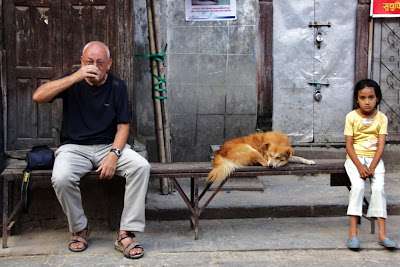 |
| Herr Nunnemann enjoys a cup of Nepali milk-and-sugar tea. |
 |
| Herr Nunnemann gets introduced to Babu of the canine security corps of Janabahaa. |
In honor of his continued interest and support to Janabahaa, we have decided to dedicate one of the flower pots that are being placed around the Janabahaa courtyard in his name.
Mit tiefer Dankbarkeit, unseren deutschen Freund! With deep gratitude, our German friend!
Photos by Alok Tuladhar.
Friday, September 24, 2010
Learning How to Click the Mouse
 |
| Photo by Bijay Shrestha |
"Novice participants produced some fantastic results after just seven or eight hours of instruction," said instructor Alok Tuladhar. He continued proudly, "the workshop has definitely proved that Janabahaa is a wonderful location to practice photography."
Raj Prajapati, a participant, says, "My last SLR was a vintage Mamiya. I have now decided to buy the Canon 60D immediately. I feel I am already a semi-professional photographer, thanks to the workshop."
Shown here are some of the works produced by the participants during the course of the workshop.
 |
| Photo by Bijay Shrestha |
 |
| Photo by Bijay Shrestha |
 |
| Photo by Bijay Shrestha |
 |
| Photo by Himan Raj Shrestha |
Wednesday, September 15, 2010
The Compass Buddha
Dhyani Buddhas are abstract aspects of Buddhahood. They are often called Tathagata or Pancha Buddha. They are so popular in Nepal that they are found in almost every chaitya, and found painted in the main entrance of many Buddhist houses.
Akshobhya is a heavenly Buddha who reigns over the eastern paradise, Abhirati. (Note that the eastern paradise is understood to be a state of mind, not a physical place.) Those who fulfill Akshobhya's vow are reborn in Abhirati and cannot fall back into lower states of consciousness.
In Buddhist iconography, Akshobhya usually is blue. He is most often pictured with his left hand resting on his lap, palm facing upward, and his right hand touching the earth, palm facing inward. This is the earth-touching mudra, which is the gesture used by the historical Buddha (Siddhartha Gautam) when he asked the earth to bear witness to his enlightenment.
In Buddhist tantra, evoking Akshobhya in meditation helps overcome anger and hatred.
So how many images of Akshobhya can be found in the Janabahaa complex? Well, it is surely worth counting.
Photo by Alok Tuladhar.
Tuesday, September 14, 2010
Soap Nuts and Elephant Ears
Age-old local techniques were used to remove the decades-old dirt (see earlier blog post entitled “Glitter under the Grime: Citrus Juice to the Rescue”). To give finishing touches to the cleaning job, two more home-grown commodities were used.
Hathan (Rittha or Soap Nuts). Scientific name Sapindus mukorossi. This natural soap is a locally grown product, and has been used traditionally as a natural cleanser.
Fakan (Karkalo or Elephant Ear/Taro). Scientific name Colocasia esculenta. The Elephant Ear plant grows in abundant quantities in the valley during the monsoon, and is used widely as a nourishing and tasty vegetable. The huge leaves of the plant is dried in the sun and boiled in water. The resulting liquid is applied on the soap-nut washed metal surface to bring out the rich glitter.
Finally, acrylic epoxy spray is applied on the surface for waterproofing.
The brilliantly-polished and waterproof Halampo will now hopefully remain so for the next few years, after which the whole process will need to be repeated.
Photos by Alok Tuladhar.
Announcing... Photography Basics Workshop
Sunday, September 12, 2010
Water! Water! Where art Thou?
Curious about this amazing work of art and its relevance to our modern day lives? Here are some excerpts from the article that appears in the online journal asianart.com in which the original water fountain has been described in detail (“The Creatures of the Rain Rivers, Cloud Lakes: Newars Saw Them, So Did Ancient India” by Gautama Vajra Vajracharya, Professor Emeritus at the University of Wisconsin, Madison and one of the foremost art historians of Nepal):
Most of the water fountains are simple, having only essential elements such as the makara spout and the images of yaksha or Bhagīratha... But some of them are much more elaborately designed as exemplified by the golden fountains of three royal palaces of the valley. Perhaps the best example is King Jitamitra Malla (reigned c. 1673-1696)’s contribution in his Bhaktapur palace (second pictured above). It shows huge head of the makara with its voluminous trunk raised upward. The makara has large eyes, curly horns, and short legs. On top of the spout, just behind the trunk an iguana like creature is crawling slowly. Both sides of the spout are crowded with aquatic and semi-aquatic creatures such as a snakes, crocodiles, ducks, turtles, and frogs and domesticated animals such as horses, goats and cows. Note also a conch shell near the foot of the makara. The human figure with bird’s feet and tail is indeed a kinnara; but in illustrated Newar iconographic texts this mythical figure is identified as jalamānus'a “aquatic man.” From the open jaws of the makara emerges a cow or a bull. This is indeed fascinating iconographic element of the Newar fountains.
Now comes the real interesting part. Continuation from Gautam V. Vajracharya’s article:
Epigraphic evidence tells us that some of these elements of water architecture go back to the Licchavi period (ca. 200-879 C.E.) or the transitional period (ca. 879-1200). During such a long period of history, the valley-dwellers developed admirable skills and techniques to bring water from considerable distances. An unpublished Sanskrit text entitled Vāriśāstra “Treatise on Water” describes how to build such water fountains. Currently, this small text is preserved in the collection of the National Archives in Kathmandu. Very likely it is composed in the valley because some part of the text is related to the technical and artistic features of the water fountains of the valley. Thus, it deserves special attention for a detailed study in the future.
Thursday, September 09, 2010
Janabahaa, the Father's Day Blessing Center
Photos by Alok Tuladhar.
Wednesday, September 08, 2010
Brothers-in-Alms
This is the fourth year the group alms collection event has been organized to help raise funds for construction of a Vihar in Lumbini. More than a million rupees has been raised from the last three years of the joint alms collection effort.
Panchadaan festival is traditionally celebrated in honor of Dipankar Buddha, and individual members of the Newar Buddhist priest cast (Shakya and Bajracharya) go from house to house to receive offerings given by devotees and to give them blessings.
When the “brothers-in-alms” arrived at Janabahaa, they were warmly welcomed by devotees who were eagerly waiting to give offerings of rice and money, in keeping with the ancient Panchadaan tradition.
Photos by Alok Tuladhar.
Sunday, September 05, 2010
Going Green
Photo by Alok Tuladhar.
Friday, August 27, 2010
Holy Cow! It's the Sa Paru Festival!
Sa Paru, or Sa Yaa, celebrated in an extravagant manner in the Kathmandu Valley, is amongst the most colorful festivals of Nepal.
The mood in the streets is quite festive.
The local chapter of Rotary Club took advantage of the festival to spread awareness about recycling of household waste.
The Machhindra Rover/Ranger Crew of Nepal Scouts, affiliated to Macchindra Club, was present as usual, helping to distribute drinking water and to keep the area clean.
Cows, wrapped in shiny yellow cloth, are paraded through the city in memory of family members who have passed away over the last year.
Boys, dressed as cows, are often used as replacement of real cows to participate in the festival.
A lady enjoys the festival, sitting on the doorway of the recently rediscovered temple of Padmapani Lokeshwor.
Tuesday, August 24, 2010
Padmapani Rediscovered
Photos by Alok Tuladhar.
